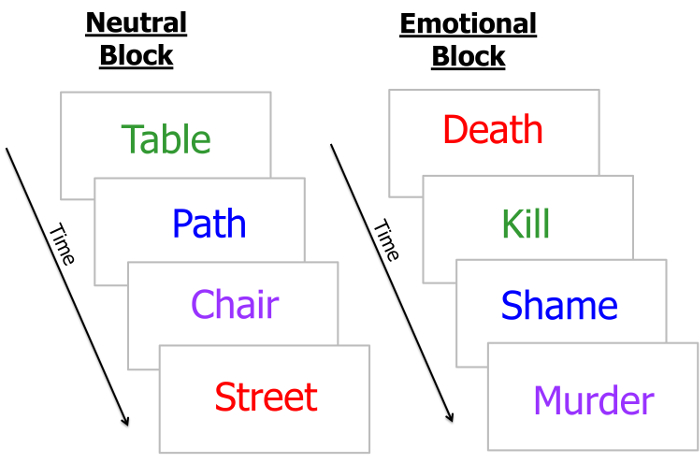情绪Stroop任务:评估下暴露的认知表现的情感内容
Summary
The emotional Stroop effect (ESE) is the result of longer naming latencies to ink colors of emotion words than those of neutral words. This report refers to potential sources of confounding and includes a modal experiment that provides the means to control for them.
Abstract
情绪Stroop效应(ESE)是更长的命名潜伏期的情感词油墨颜色比的中性词油墨颜色的结果。差表明,人们通过由载体词语传达即使它们是不相关的手头的颜色命名任务情感内容的影响。东南已广泛部署了患者群体,以及与非选择的人群,由于情感词语可以被选择以匹配测试病理。该ESE是一个强大的工具,但它很容易受到它的有效性的各种威胁。这个报告是指混杂潜在来源,并且包括一个模式的实验,提供了控制对他们的装置。到现有的ESE研究的有效性最普遍的威胁是持续的效果和习惯通过重复暴露于情绪刺激造成的。因此,暴露于情感和中性刺激的顺序是非常重要的。我们表明,在备用ARD的设计,只有一个特定的顺序产生ESE。
Introduction
现代生活充满了情感和压力。谁避免了急诊室或(见证)交通事故?为了在这种紧张的情况下有效地执行,它通过关注相关刺激以保持自己的冷静是非常重要的。然而,研究已经表明,刺激的情绪价可以影响的关注,特别是调制处理的速度。在实验室中,最流行的范例之一,研究负刺激对性能的影响是情感的Stroop任务。典型的发现是,它需要较长的人来命名的情感的话比的中性词墨水颜色,情绪Stroop效应(ESE)。有迹象表明,试图解释所观察到的经济放缓归因关注3有数个账户,冻结2或3的心情,但它仍然是目前争论的问题。
情绪的Stroop T的实验装置问是众所周知的。在颜色词可以单独使用,提出了看法和参与者的任务就是尽可能快速,准确地命名每个单词的墨水颜色。这句话来自于两类不同价的。第一类包括否定词( 例如 ,死亡)或与特定精神病理学的话( 例如 ,强迫患者或创伤后应激障碍患者BATTLE芽)。第二类包括中性词( 例如 ,椅子)。该ESE是情感和中性词之间的颜色命名潜伏期的差异。的刺激可以在与情感和以随机方式或在单词类别定义了两个独立的块混合中性词语单个块被呈现。当东南导出处于阻塞设计4,5,因此,块设计成为首选的ESE的研究方法与情感词语的减速通常更明显,这是方法在该协议适用的(参阅图1为情绪Stroop实验装置的说明)。

图1:在情绪Stroop任务的实验阵列:参与者的任务就是来命名出现的单词的颜色,请单击此处查看该图的放大版本。
它以ESE从旧的同名经典Stroop效应(SE)6区分是很重要的。在经典的Stroop任务, 颜色 词 ,如红色或绿色的各种油墨颜色呈现和参与者的任务就是说出的话的墨水颜色。尽管共同任务 – 识别单词的墨水颜色 – 东南和ESE不同。因为字是颜色的话,在经典的Stroop任务分为全等刺激(字命名的墨水颜色)和不一致(字和颜色冲突)两类。在SE被定义为在一致和不一致刺激之间颜色命名性能上的差异。由于一致性的质量并不在ESE适用于刺激 – 蓝色字癌症既不比棕色字讲座不多也不少一致 – 不会在ESE环境中定义的SE。东南记录对性能的刺激的情绪价的效果。
在ESE,就像SE,产生了大量的研究。事实上,ESE其对手与患者和非患者人群实验研究纯粹的同名输出(综述,见1,7)。该任务已被用来从广泛性焦虑病状的色域( 例如 ,8,9)特质焦虑( 例如.G。,10,11),以强迫症( 例如 ,12,13)到抑郁9,14到社交恐怖症15,16创伤后应激障碍( 例如 ,17,18)。东南还研究了与未被选中的人群( 如,2,3,19,20),虽然在希西参与者的效果并不总是观察到,并且通常不太明显。至少,它不是基于自我报告,而不是侵入ESE的普及的一部分是由于它的客观性质。此外,情绪话可以选择挖掘特定病理或患者的当前关注。
下面,我们描绘设计并执行一个情绪Stroop实验所需的步骤。我们在本报告中的目的是详细描述所需要控制一个ESE实验。该设计的最重要的特点是它提供了对到有效性各种威胁的控制。在本设计中处理的主要威胁是习惯的。通过这些程序呈现ESE下的情感评估关注的一个有效和可靠的手段。
Protocol
Representative Results
Discussion
该ESE包括非常简单的任务:参加者的名字单独呈现的话墨水颜色。双方务实和理论后果这个简单的任务产生的结果。该ESE记录的事实,人是敏感,情绪价在刺激entailed虽然这种功能完全无关手头的任务。
该ESE已经发展成为一个非常流行的方法,用于探测情绪和焦虑患者和非患者人群1,7 4。它的魅力可以归因于它的潜力作为一个目标(基于计算机)的诊断?…
Divulgaciones
The authors have nothing to disclose.
Acknowledgements
The authors have no acknowledgements.
Materials
| DirectRT software | Empirisoft | http://www.empirisoft.com/directrt.aspx | Software allows easy programing of a custom experiment in a spreadsheet application (e.g., Excel) |
| Personal computer | Any | https://www.office.com/ | At least 256mb of memory, a graphics card with at least 16mb of video memory and a processor speed of at least 500mhz. |
| A spreadsheet application (e.g., Excel) | Microsoft | Any version | A spreadsheet application capable of editing CSV files |
| SPSS/STATISTICA software | IBM/Statsoft | http://www-01.ibm.com/software/analytics/spss/ http://www.statsoft.com/ | Statistical software |
Referencias
- Williams, J.M.G., Mathews, A., & MacLeod, C. The emotional stroop task and psychopathology. Psychol.Bull. 120 (1), 3-24, (1996).
- Algom, D., Chajut, E., & Lev, S. A rational look at the emotional Stroop phenomenon: A generic slowdown, not a Stroop effect. J. Exp. Psychol. Gen. 133 (3), 323-338, (2004).
- Ben-Haim, M.S., Mama, Y., Icht, M., & Algom, D. Is the emotional Stroop task a special case of mood induction? Evidence from sustained effects of attention under emotion. Atten. Percept. Psycho. 76 (1), 81-97, (2014).
- Holle, C., Neely, J.H., & Heimberg, R.G. The effects of blocked versus random presentation and semantic relatedness of stimulus words on response to a modified Stroop task among social phobics. Cognitive Ther. Res. 21 (6), 681-697, (1997).
- Richards, A., French, C.C., Johnson, W., Naparstek, J., & Williams, J. Effects of Mood Manipulation and Anxiety on Performance of an Emotional Stroop Task. Br.J.Psychol. 83, 479-491 (1992).
- Stroop, J.R. Studies of Interference in Serial Verbal Reactions (Reprinted from Journal Experimental-Psychology, Vol 18, Pg 643-662, 1935). J. Exp. Psychol. Gen. 121 (1), 15-23 (1992).
- Bar-Haim, Y., Lamy, D., Pergamin, L., Bakermans-Kranenburg, M.J., & van IJzendoorn, M.H. Threat-related attentional bias in anxious and nonanxious individuals: A meta-analytic study. Psychol.Bull. 133 (1), 1-24, (2007).
- Mathews, A., Mogg, K., Kentish, J., & Eysenck, M. Effect of Psychological Treatment on Cognitive Bias in Generalized Anxiety Disorder. Behav. Res. Ther. 33 (3), 293-303, (1995).
- Mogg, K., & Bradley, B.P. Attentional bias in generalized anxiety disorder versus depressive disorder. Cognitive. Ther. Res. 29 (1), 29-45, (2005).
- Mogg, K., Kentish, J., & Bradley, B.P. Effects of Anxiety and Awareness on Color-Identification Latencies for Emotional Words. Behav. Res. Ther. 31 (6), 559-567, (1993).
- Rutherford, E.M., MacLeod, C., & Campbell, L.W. Negative selectivity effects and emotional selectivity effects in anxiety: Differential attentional correlates of state and trait variables. Cognition. Emotion. 18 (5), 711-720, (2004).
- Foa, E.B., Ilai, D., Mccarthy, P.R., Shoyer, B., & Murdock, T. Information-Processing in Obsessive-Compulsive Disorder. Cognitive. Ther. Res. 17 (2), 173-189, (1993).
- Mcnally, R.J., Riemann, B.C., Louro, C.E., Lukach, B.M., & Kim, E. Cognitive Processing of Emotional Information in Panic Disorder. Behav. Res. Ther. 30 (2), 143-149, (1992).
- Mitterschiffthaler, M.T., et al. Neural basis of the emotional Stroop interference effect in major depression. Psychol.Med. 38 (2), 247-256, (2008).
- Amir, N., Freshman, M., & Foa, E. Enhanced Stroop interference for threat in social phobia. J.Anxiety Disord. 16 (1), 1-9, (2002).
- Andersson, G., Westoo, J., Johansson, L., & Carlbring, P. Cognitive bias via the Internet: A comparison of web-based and standard emotional Stroop tasks in social phobia. Cognitive Behaviour Therapy. 35 (1), 55-62, (2006).
- Paunovic, N., Lundh, L.G., & Ost, L.G. Attentional and memory bias for emotional information in crime victims with acute posttraumatic stress disorder (PTSD). J.Anxiety Disord. 16 (6), 675-692, (2002).
- Constans, J.I., McCloskey, M.S., Vasterling, J.J., Brailey, K., & Mathews, A. Suppression of attentional bias in PTSD. J.Abnorm.Psychol. 113 (2), 315-323, (2004).
- Mama, Y., Ben-Haim, M.S., & Algom, D. When emotion does and does not impair performance: A Garner theory of the emotional Stroop effect. Cognition.Emotion. 27 (4), 589-602, (2013).
- Mckenna, F.P., & Sharma, D. Intrusive Cognitions – an Investigation of the Emotional Stroop Task. J. Exp. Psychol. Learn. 21 (6), 1595-1607, (1995).
- Grainger, J., Oregan, J.K., Jacobs, A.M., & Segui, J. On the Role of Competing Word Units in Visual Word Recognition – the Neighborhood Frequency Effect. Percept.Psychophys. 45 (3), 189-195, (1989).
- Balota, D.A., et al. The English Lexicon Project. Behav. Res. Methods. 39 (3), 445-459, (2007).
- Larsen, R.J., Mercer, K.A., & Balota, D.A. Lexical characteristics of words used in emotional Stroop experiments. Emotion. 6 (1), 62-72, (2006).
- McKenna, F.P., & Sharma, D. Reversing the emotional stroop effect reveals that it is not what it seems: The role of fast and slow components. J. Exp. Psychol. Learn. 30 (2), 382-392, (2004).
- Frings, C., Englert, J., Wentura, D., & Bermeitinger, C. Decomposing the emotional Stroop effect. Q.J.Exp.Psychol. 63 (1), 42-49, (2010).
- Eidels, A., Ryan, K., Williams, P., & Algom, D. Depth of Processing in the Stroop Task Evidence From a Novel Forced-Reading Condition. Exp. Psychol. 61 (5), 385-393, (2014).
- Wegner, D.M. Ironic Processes of Mental Control. Psychol.Rev. 101 (1), 34-52, (1994).
- Kendall, P.C., Finch, A.J., Auerbach, S.M., Hooke, J.F., & Mikulka, P.J. State-Trait Anxiety Inventory – Systematic Evaluation. J.Consult.Clin.Psychol. 44 (3), 406-412, (1976).
- Dresler, T., et al. Reliability of the emotional Stroop task: An investigation of patients with panic disorder. J.Psychiatr.Res. 46 (9), 1243-1248, (2012).
- Eide, P., Kemp, A., Silberstein, R.B., Nathan, P.J., & Stough, C. Test-retest reliability of the emotional stroop task: Examining the paradox of measurement change. J.Psychol. 136 (5), 514-520 (2002).
- Macleod, C., Mathews, A., & Tata, P. Attentional Bias in Emotional Disorders. J.Abnorm.Psychol. 95 (1), 15-20, (1986).

